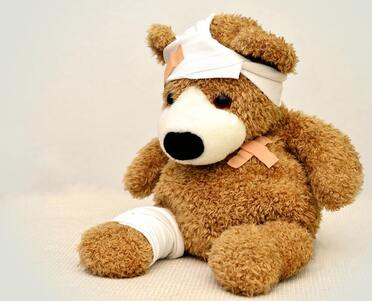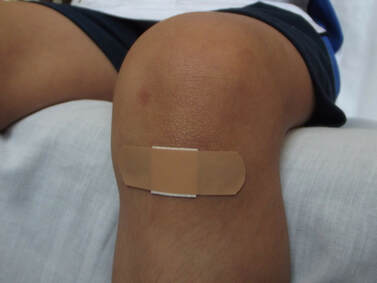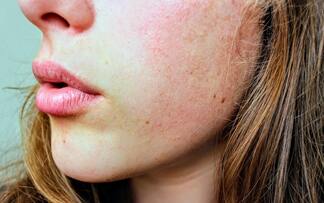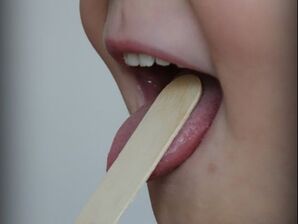|
Sooner or later, every child will fall and strike his or her head. Falls are especially common when your child is learning to walk. Most head injuries simply result in a scalp injury. Big bumps can occur with minor injuries because the blood supply to the scalp is so plentiful. For the same reason, small cuts on the scalp or face can bleed profusely.
Home Care Steps: 1) If there is a scrape, wash it off with soap and water. 2) Apply pressure with a clean cloth for 10 minutes to stop any bleeding. 3) For swelling, apply ice for 20 minutes. (Frozen vegetables such as peas work well or keep a wet sponge in a zippered bag in the freezer). For more serious head injuries, look for the following symptoms:
Call our office immediately if:
Comments
A bump or bruise may cause damage to superficial blood vessels, resulting in a black and blue mark. Since the skin is not broken, there is no risk of infection. Bruises usually follow injury caused by blunt objects.
Unexplained bruises may indicate a bleeding tendency. However, unexplained bruises overlying the shins are usually not a sign of a bleeding tendency. Children often bump this area and then forget about it. Home Care Steps: 1) Apply ice to the bruised area for 20-30 minutes. 2) No other treatment should be necessary. Optional: Give acetaminophen (Tylenol) or Ibuprofen (Motrin) for pain relief. Avoid aspirin. Bruises usually resolve in about 2 weeks. During this time, the color will change from blue to green to yellow. Note: If a blood blister is present do not open it due to increased risk of infection. It will dry up and peel off in 1-2 weeks. Call our office immediately if:
These wounds occur when the skin has been completely punctured by an object that is narrow and sharp, such as a nail. Since puncture wounds usually seal over quickly, there is a greater chance of wound infection.
Home Care Steps: 1) Soak the wound in warm water and soap for 15 minutes. 2) Scrub the wound with a washcloth to remove any debris. 3) Cut off any flaps of loose skin that cover the wound and interfere with drainage or removing debris. 4) Apply an antibiotic ointment and a bandaid to reduce the risk of infection. 5) Re-soak the area and reapply antibiotic ointment every 12 hours for 2 days. 6) Give acetaminophen (Tylenol) or Ibuprofen (Motrin) for pain relief. Call our office immediately if:
An abrasion is an area of superficial skin that has been scraped off during a fall, such as a skinned knee. Wash the wound for at least 5 minutes with warm water and soap. The area will probably need to be gently scrubbed several times to get out all the dirt. You may have to remove some dirt particles with a pair of tweezers. Pieces of loose skin may be cut off with clean scissors. Apply an antibiotic ointment and cover the scrape with a bandaid or gauze dressing. Cleanse the area once a day with warm water and then reapply the ointment and dressing until the scrape is healed. Give acetaminophen (Tylenol) or Ibuprofen (Motrin) for pain relief.
Call our office immediately if:
Be careful with pots, warm air humidifiers, cooking on the stove, hot cups of coffee and soup on the table, matches, fireplaces and of course electrical outlets. Be aware that exposed surfaces of ovens and radiators are sometimes hot enough to cause burns.
First-degree burns are mild and result in redness, slight swelling, and pain. Sunburns are usually first-degree burns. Second-degree burns cause blistering and more intense swelling and pain. Third-degree burns are serious and life threatening, causing charring and destruction of all the skin layers. Usually you can treat a first-degree burn yourself by soaking the burned area in cool water for 10 minutes. Keep it clean, dry and free from sun exposure until it heals. Second-degree burns require our attention, particularly if they occur on the face, hands or feet. First, soak the burned area in cold water. When you bring your child to the office, cover the burn with sterile gauze or a clean cloth (not absorbent cotton). Try not to pop the blisters. Give acetaminophen (Tylenol) or ibuprofen (Motrin) for pain relief. Third-degree (full-thickness) burns require emergency treatment at the nearest hospital. Call 911 immediately. [HOW DO YOU KNOW IF IT'S 1st/2nd/3rd DEGREE?] Most rashes need to be evaluated in the office. There are many different types and causes of rashes.
Call our office immediately if:
Call our office during regular hours if:
Babies commonly grunt, push, strain, draw up their legs and become flushed in the face during passage of BMs. However, these behaviors are normal as long as their stool is soft. The painful passage of hard stools is the most reliable sign of constipation in infants and in older children. These children feel a desperate urge to have a bowel movement (BM) but are unable to pass a BM after straining and pushing for more than 10 minutes.
Some children begin to retain stool in order to avoid the pain of passing a hard BM. These children may start to soil themselves as the watery stool in the upper intestines leaks around the impaction. Constipation is often due to a diet that does not include enough fiber or fluids or due to drinking or eating too many dairy products or starchy foods. It is also caused by repeatedly waiting too long to move the bowels. If constipation begins during toilet training, too much pressure may be being placed on the child. Changes in the diet frequently relieve constipation. After your child is better, be sure to keep him on a non-constipating diet so that it doesn’t happen again. Diet treatment for infants less than 1 year of age include:
Diet treatment for infants older than 1 year of age:
Call our office immediately if:
Call our office during regular hours if:
Most vomiting is caused by a viral infection of the stomach (viral gastroenteritis) or eating something that is tainted. It can occur with diarrhea or by itself. In infants, it is important to distinguish between normal amounts of spitting up and vomiting. Many normal infants may have mild reflux and may spit up small amounts of undigested milk soon after feeding. Often, the viral type is associated with diarrhea. The expected course is usually 12 to 24 hours Dietary changes usually speed recovery. If diarrhea is present, it usually continues for several days to a week.
Home care for vomiting includes special dietary changes according to age and normal diet. For bottle-fed infants less than 1 year of age, offer oral rehydration solutions (ORS), such as Infalyte or Pedialyte, for 8 hours. Offer small amounts (1 teaspoon) every 5 minutes for the first hour, then 2 teaspoons every 10 minutes, then 3 teaspoons every 15 minutes. You should aim for total of about 2 ounces per hour, After 4 hours without vomiting, increase the amount. After 6-8 hours without vomiting, return to formula. For infants more than 4 months of age, also return to cereal, bananas, etc. A normal diet is okay in 24 to 48 hours. If your child refuses the Pedialyte, you may give Gatorade, herbal tea, chicken broth or flat sodas. Coca cola syrup is particularly effective in “settling” the stomach.” Try to avoid diet sodas and plain water since they lack any sugar and electrolytes. Once your child has managed to tolerate fluids for at least four hours, you may offer mild foods as tolerated. For breast-fed infants, reduce the amount or feeding and feed more frequently. Your goal is to avoid filling the stomach. Nurse for 5 minutes every 1-2 hours. After 6-8 hours without vomiting, return to regular breast-feeding. For children over 1 year of age, offer clear fluids (water, Pedialyte, or Gatorade) in small amounts for 8 hours. Give small amounts (1 tablespoon) every 10 minutes. After 4 hours without vomiting, increase the amount. For severe vomiting, rest the stomach completely for 1 hour, then start over with smaller amounts. Add bland foods after 6 hours without vomiting. Stay on bland, starchy foods (saltine crackers, white bread, rice, mashed potatoes, etc.) for 24 hours. Call our office immediately if:
Most sore throats are caused by viruses and are part of a cold. However, about 30% are due to the strep bacteria.
A throat culture or rapid strep test is the only way to distinguish strep throat from viral infection. To provide local pain relief, children over 8 years of age can gargle with warm salt water (1/4 teaspoon of salt per 6-8 oz water). Children over 4 years of age can suck on hard candy, like butterscotch or lollipops, as often as necessary. Children over 1 year can sip on warm chicken broth. Most are due to a viral infection and are part of a cold. Keep in mind that coughing clears the lungs and protects them.
Use cough drops for children over 4 years old and warm liquids, like chicken broth for children over 1 year of age. We generally avoid the use of cough suppressants. Dry air tends to make coughs worse. Use a cool mist humidifier in your child’s bedroom to loosen a dry cough. A steamy bathroom works well. Encourage plenty of fluid intake. Call our office immediately if:
Call our office during regular hours if:
We discourage the use of all cough medicines in children under the age of 6 years.
For children over the age of 6 years, if the cough is disrupting sleep and an over-the counter cough medicine or decongestant is effective, try to limit its use to once in the a.m. and once in the p.m. In order to diagnose a fever, first check your child's temperature (Is It a Fever?).
For children ages 2-12 years, you may follow the instructions on the bottle. However, the best method of dosing for all children under 80 pounds, and especially for babies, is to dose based on weight. When dealing with a high fever, it is always best to use the full dose for weight, as it will be more effective than a small dose. For medication dosing, fever is generally considered any temperature greater than 101.4°F (38°C). In order to clinically evaluate your child, it is important to get the fever down by administering the proper dose of Tylenol or Motrin. Do not give Tylenol before two months of age unless directed to do so by your doctor. Give only Tylenol at 15 mg/kg body weight between 2 and 6 months of age, every four hours. After 6 months of age, you may give either Tylenol at 15 mg per kilo of body weight every 4 hours or Motrin 10 mg/kg of body weight, every 6-8 hours. It is ordinarily not necessary to alternate Tylenol and Motrin.
For high fevers over 103°F, we may suggest that you alternate Tylenol and Motrin for 24 hours. When alternating them, the same dosages are used. Each is given every 6 hours, so that medication is being given every three hours: 12PM Tylenol, 3PM Motrin, 6PM Tylenol, 9PM Motrin, etc. |
AuthorThe staff of Panda Pediatrics, located in Washington, D.C. Categories
All
Archives |
|
Schedule your visit today!
|
HOURSMon: 9am-5pm
Tues: 9am-5pm Wed: 9am-5pm Thurs: 9am-5pm Fri: 9am-2pm Closed daily 12pm-1pm. |
Phone: 202-466-5350
Fax: 202-466-8555 After Hours: 703-535-1856 Email: [email protected] Billing: 1-888-969-3735, option# 1 |
ADDRESS2440 M Street NW
Suite #422 Washington, DC 20037 POLICIES |










 RSS Feed
RSS Feed

